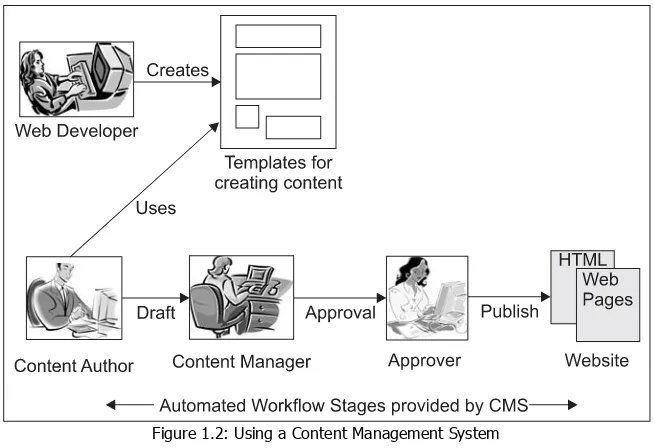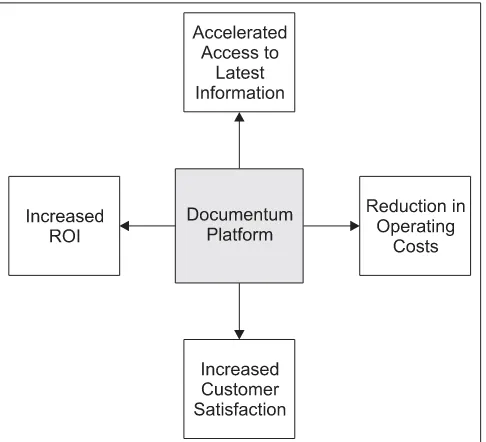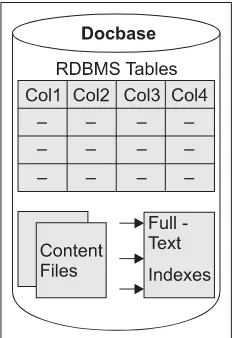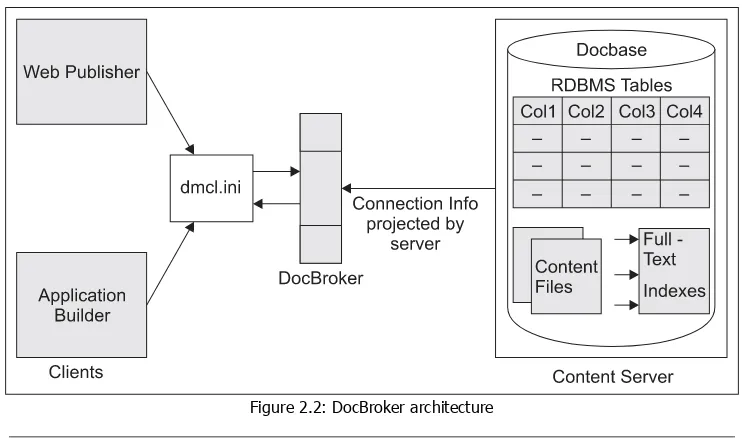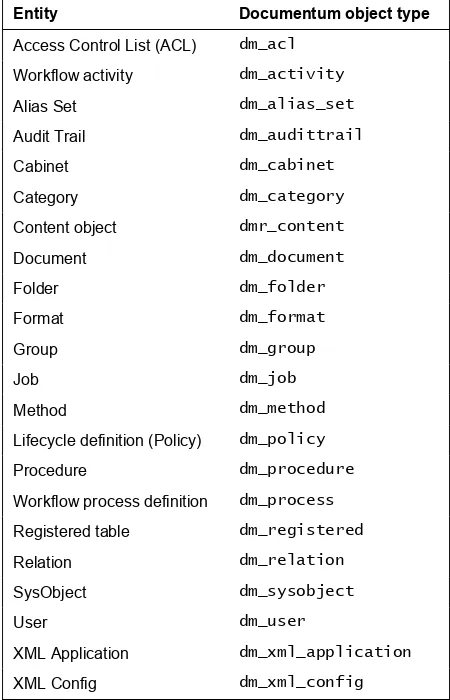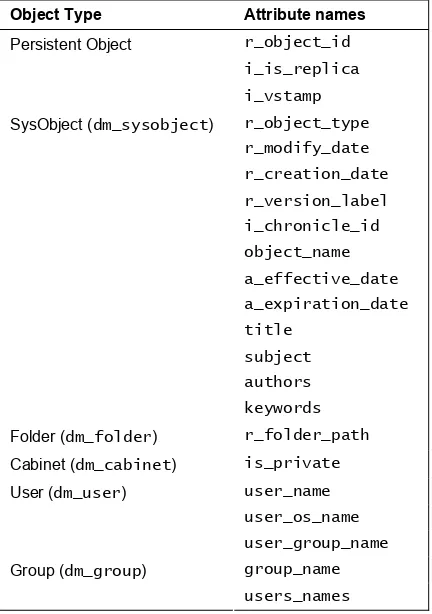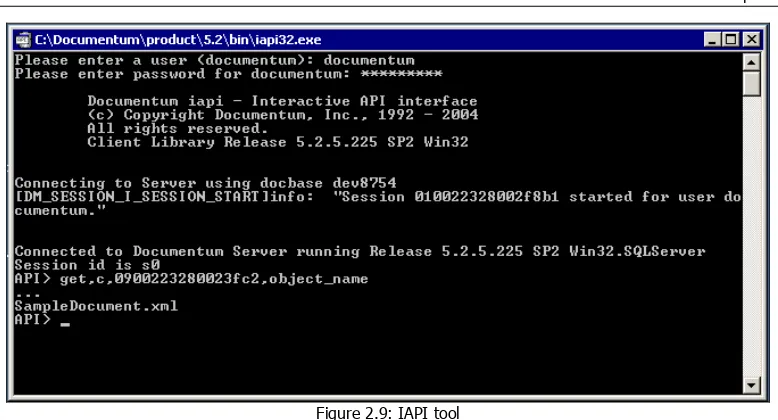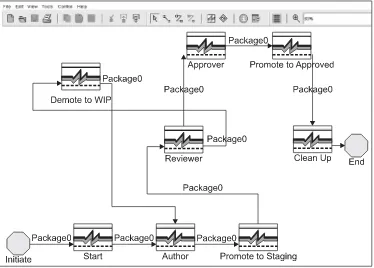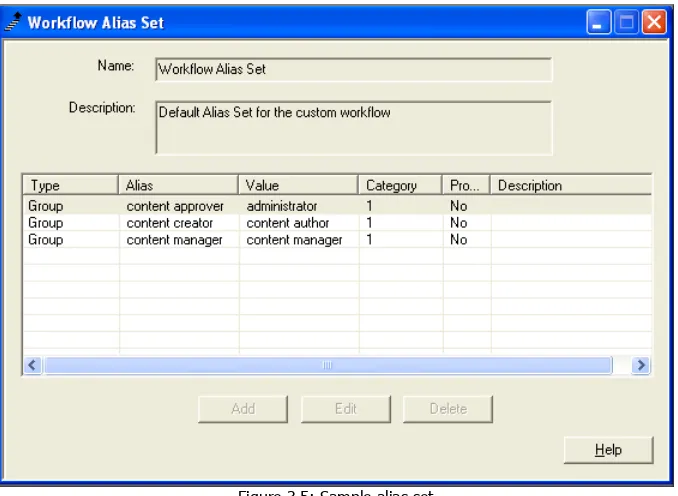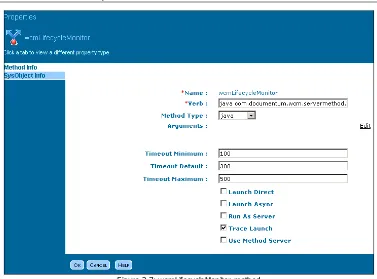€ 68.99 EU
repository. With the Web Content Management suite of applications, you can efficiently manage
to grow your skills and confidence. You will see tips and tricks to handle the complexities of the
• Install, configure, and get started with Documentum
• Create Rules and Presentation files
• Master workflows and create custom workflows
depth of coverage means that experienced Documentum developers will also benefit from the
Web Content Management with
Documentum
Set up, Design, Develop, and Deploy Documentum Applications
Concise, practical information on Documentum Web Content Management
to get the most from this system
F r o m T e c h n o l o g i e s t o S o l u t i o n s
Gaurav Kathuria
Web Content Management with
Documentum
Set up, Design, Develop, and Deploy
Documentum Applications
Concise, practical information on Documentum Web
Content Management to get the most from this system
Gaurav Kathuria
Web Content Management with Documentum
Set up, Design, Develop, and Deploy Documentum Applications
Copyright © 2006 Packt Publishing
All rights reserved. No part of this book may be reproduced, stored in a retrieval system, or transmitted in any form or by any means, without the prior written permission of the publisher, except in the case of brief quotations embedded in critical articles or reviews.
Every effort has been made in the preparation of this book to ensure the accuracy of the information presented. However, the information contained in this book is sold without warranty, either express or implied. Neither the author, Packt Publishing, nor its dealers or distributors will be held liable for any damages caused or alleged to be caused directly or indirectly by this book.
Packt Publishing has endeavored to provide trademark information about all the companies and products mentioned in this book by the appropriate use of capitals. However, Packt Publishing cannot guarantee the accuracy of this information.
First published: June2006
Production Reference: 1130606
Published by Packt Publishing Ltd. 32 Lincoln Road
Olton
Birmingham, B27 6PA, UK.
ISBN 1-904811-09-4
www.packtpub.com
Credits
Author
Gaurav Kathuria
Development Editor
Douglas Paterson
Assistant Development Editor
Nikhil Bangera
Technical Editor
Ashutosh Pande
Editorial Manager
Dipali Chittar
Indexer
Niranjan Jahagirdar
Proofreader
Chris Smith
Production Coordinator
Manjiri Nadkarni
Layouts and Illustrations
Shantanu Zagade
Cover Designer
About the Author
Gaurav Kathuria completed his B. Tech. (Hons.) in Chemical Engineering from I.I.T. Kharagpur in the year 2000 and has since been a prominent performer in diverse software fields, from IT services through product development to software consultancy.
He has a rich experience of designing, developing, and managing software systems using object-oriented languages and technologies like Java/J2EE and Documentum.
He started working with Documentum 4i in the year 2001 and has ever since had an extensive experience architecting/designing complex Documentum 4i and 5x projects.
He has also given in-house training on Documentum system architecture, fundamentals, and Web Publisher in many of the organizations he has worked in.
This book is dedicated to
God: Who has always showered his choicest blessings on me and given me much more than I ever wanted in my life. I thank Him for all that he has done for me.
My family: My father (Mr. P.N. Kathuria) has always been a guiding star in my life, mentoring and steering me through thick and thin. Extremely diligent and sincere in all his endeavors; I have learnt and am still learning a lot from him.
My mother (Mrs. Sarita Kathuria) has selflessly devoted her entire life for the well-being of our sweet little family. She has always been the shoulder I cried on when I was in distress and she has been the one who praised me most when others disapproved me.
My sister (Ms. Gunjan Kathuria) is the sweet little sister I always wanted in my life. Her affection and care has given a new meaning to my life.
My wife (Mrs. Gunjan Grover) has blossomed our house with love and respect for everyone. Her mere presence fills up and completes the missing bit in my life…
My friends: Neeraj Jain, Nisha, Hima, Nishant Anchal, and Abhishek Singh, who have always been by my side, making this world a better place to live in.
Documentum team mates: Mansoor Sheikh, Arnab Ghosh, Amit Kapur, Prashant Shukla, Gajendra Sahu, Gurmeet Singh, Prasun Misra, Tanveer Haider, Arpana Bansal, Preeti Dua, Kapil Bharati, Akash Narang, Kesavan, Usha Parolkar, Anjali Nanda, and other software professionals with whom I have worked on various Documentum projects. They all have been a source of inspiration for me in some way or the other.
Acknowledgements
Dr. Louay Fatoohi, Dr. Douglas Paterson, and the entire crew at Packt Publishing Ltd. for honoring me by publishing this book in the most stringent of timeframes.
Johnson Stephen: My pal, colleague, and a software testing maestro. He 'unknowingly' guided me to write a book as a precursor to establishing myself and starting up my own consultancy in future.
M. Scott Roth: Author of 'A Beginner's Guide to Developing Documentum Desktop Applications'.
Scott applauded my decision to write this book on Documentum technology and constantly provided the much needed support and zeal.
Anil Baid: The owner and head of 'Solutions Infosystems'. He has been an extremely helping hand for me, without whom this book would have never seen the light of day.
Rakesh Dahiya: The Facilities manager at 'Solutions Infosystems' who guided me often regarding the various publishing avenues available and the tips and tricks of the trade.
Ashwin Razdan: Media Manager, whatistesting.com; an extremely versatile personality who assisted me in getting the book shaped up to the right standards by providing the much needed direction and support.
Sachin Jain: The Accounts and legal head at 'Solutions Infosystems' whose valuable advice steered me clear of several difficult situations during the book authoring process.
Pankaj Jain and Pradeep Gautam ('Econsultants India').
Table of Contents
Preface 1
Chapter 1: Content and Documentum
5
1.1 Need for an Effective CMS 7
1.2 Qualities of a Good CMS 8
1.3 Why Documentum? 10
1.4 Documentum Features 11
1.5 Summary 12
Chapter 2: Documentum Essentials
13
2.1 Documentum Cornerstone 13
2.6.1 Object ID (Object Identifier: r_object_id Attribute) 19
2.6.2 Attribute Types 19
2.7 DQL 21
2.8 API 22
2.9 Cabinets and Folders 23
2.10 Versioning 24
2.11 Lifecycles 25
2.12 Workflows 26
2.13 Summary 28
Chapter 3: Documentum Advanced Concepts
29
Table of Contents
3.7 Alias Set 34
3.8 Users and Groups 36
3.8.1 Users 36
3.8.2 Groups 36
3.9 Renditions 37
3.10 Registered Tables 38
3.11 Data Dictionary 38
3.12 Methods and Jobs 39
3.12.1 Methods 39
3.12.2 Jobs 40
3.13 Summary 42
Chapter 4: Web Content Management System
43
4.1 When Should you Use a WCM System? 43
4.2 When Should you Not Use a WCM System? 44
4.3 Documentum WCM Architecture 45
4.4 How do you Enter Content in the System? 46
4.4.1 Web Publisher 46
4.5 Where and How is the Content Stored? 47
4.5.1 Content Server 47
4.6 How do you Perform System Administration? 48
4.6.1 Documentum Administrator 48
4.7 How do you Create Multiple Renditions of the Content? 50
4.7.1 Content Rendition Services 50
4.8 How do you Publish Content to a Website? 52
4.8.1 Site Caching Services 52
4.8.2 SCS Architecture 53
4.9 How do you Query the Published Content for Displaying on
Websites? 54
4.9.1 Documentum JDBC Services 54
4.10 How do you Deploy Website Content to a Server Farm? 55
4.10.1 Site Deployment Services 55
4.11 Summary 56
Chapter 5: Setting Up the Documentum Suite
57
5.1 Installing Content Server 58
5.1.2 Prerequisites 59
Table of Contents
5.2 Installing Content Server 5.2.5 60
5.3 Installing Content Server 5.2.5 SP2 64
5.4 Summary 66
Chapter 6: Creating Our First Docbase
67
6.1 Creating a Docbase 67
6.2 Installing Web Publisher Server Files and DocApp 75
6.2.1 What does Web Publisher Server Files Contain? 76 6.2.2 What does WebPublisher DocApp Contain? 76
6.3 Beginning Installation 76
6.4 Stopping and Starting Docbase and DocBroker 80
6.5 dmcl.ini 81
6.6 server.ini 81
6.7 Summary 82
Chapter 7: Setting Up Publishing
83
7.1 SCS Source 5.2.5 83
7.1.1 Prerequisites 84
7.1.2 Installing SCS Source 5.2.5 84
7.1.3 Installing SCS Source 5.2.5 SP2 88
7.2 SCS Target 5.2.5 89
7.2.1 Prerequisites 89
7.2.2 Installing SCS Target 5.2.5 89
7.2.3 Installing SCS Target 5.2.5 SP2 97
7.3 Summary 98
Chapter 8: Setting Up Documentum Application Builder
99
8.1 Documentum Application Builder 100
8.1.1 Prerequisites 101
8.2 Installing DAB 5.2.5 SP2 101
8.3 Summary 105
Chapter 9: Setting Up Documentum Administrator and Web Publisher 107
9.1 Documentum Administrator 107
9.1.1 Prerequisites 108
9.1.2 Installing Documentum Administrator 5.2.5 SP2 108
Table of Contents
9.2 Web Publisher 113
9.2.1 Prerequisites 113
9.2.2 Installing Web Publisher 5.2.5 SP2 113
9.3 Summary 118
Chapter 10: Designing Documentum Applications
119
10.1 Case Study—Simple Newspaper Website 119
10.2 Beginning Documentum Design 121
10.3 Using Documentum Application Builder (DAB) 122
10.4 Creating Custom Objects in DocApp 123
10.5 Summary 124
Chapter 11: Designing and Creating Custom Object Types
125
11.1 Creating Object Types 126
11.1.1 Type Names 127
11.1.2 Limitations of Object Type Names 127
11.1.3 Supertype 128
11.2 Designing and Creating Custom Attributes of Object Type(s) 137
11.3 Adding Attributes to an Object Type 138
11.3.1 Attribute Names 139
11.3.2 Limitations of Object Type Attribute Names 139
11.3.2.1 Label 140
11.3.2.2 Data Type 140
11.3.2.3 Length 140
11.3.2.4 Repeating 140
11.3.2.5 Default Search Value 140
11.3.2.6 Allowable Search Operators 140
11.3.2.7 Input Mask 141
11.3.2.8 Conditional Value Assistance 145
11.4 Querying Registered Tables using DQL for Value Assistance 149
11.5 $value() Keyword 153
11.6 Summary 155
Chapter 12: Creating Lifecycles, Alias Sets, and Permission Sets 157
12.1 Alias Sets in a Lifecycle 157
12.2 Creating an Alias Set 158
12.3 Creating Permission Sets 161
12.4 Creating a Custom Lifecycle 163
12.5 Promoting and Demoting Content through a Lifecycle 178
Table of Contents
12.5 Expiring Content 183
12.6 Summary 185
Chapter 13: Working with Web Publisher Template Files
187
13.1 Creating a Template File 190
13.2 Summary 194
Chapter 14: Creating Rules Files
195
14.1 Creating a Rules File 195
14.1.1 IMGALTTEXT Element 205
14.2 Final Template in Web Publisher Editor 208
14.3 Miscellaneous Rules File Widgets 210
14.3.1 Choice Widget 210
14.3.2 Checkbox Widget 210
14.3.3 Textselector Widget 210
14.3.4 Xselector Widget 211
14.4 Summary 212
Chapter 15: Creating Presentation Files
213
15.1 Creating a Presentation File 214
15.2 Viewing Content Renditions 220
15.3 Reapplying Presentation Files 221
15.4 Using XDQL in Stylesheets 222
15.5 XDQL Example in XSL Stylesheet 223
15.6 Create_Dynamic_Content Job 227
15.7 Summary 229
Chapter 16: Folder Mapping
231
16.1 Anatomy of the FolderMap.xml File 234
16.2 Limitations of Folder Map 234
16.3 Folder Mapping Examples 235
16.3.1 Property Matching: Using Wildcard (*) 235 16.3.2 Property Matching: Using Multiple Properties in <attr_list> 237 16.3.3 Placing a Content File in Multiple Locations with <path_list> 239 16.3.4 Property Matching: Simple Repeating Attribute 241
Table of Contents
16.3.5 Property Matching: Repeating Attribute Index 244
16.3.6 Dynamic Folder Mapping 246
16.3.7 Dynamic Folder Mapping with Repeating Attribute 248
16.4 Summary 250
Chapter 17: Using Instruction Files
251
17.1 Limitations of Instruction Files 252
17.2 Instruction File Examples 253
17.2.1 Deleting an XML Element from an XML File with <delete-element> 253 17.2.2 Adding an XML Element to an XML File with <insert-element> 262 17.2.3 Updating the Value of an XML Element in an XML File with
<update-element-value> 265
17.3 Summary 267
Chapter 18: Automatic Property Extraction (APE)
269
18.1 How Automatic Property Extraction Works 270
18.2 Simple Example for Automatic Property Extraction 271
18.3 Testing our First XML Application 277
18.4 Populating Repeating Attributes using Automatic Property
Extraction 280
18.5 Testing the Second XML Application 282
18.6 Using Two-Way Attribute Extraction 285
18.7 Testing the Two-Way Attribute Extraction XML Application: 287
18.8 Summary 290
Chapter 19: Working with Workflows
291
19.1 Designing Custom Workflows 292
19.2 Setting Up a Custom Workflow Template 293
19.3 Creating a Custom Workflow Template 300
19.3.1 Performer Tab for Activities 312
19.3.2 Trigger Tab for Activities 312
19.3.3 Notification Tab for Activities 313
19.3.4 Transition Tab for Activities 313
19.4 Adding a Package to Connection Flows 314
19.5 Summary 315
Table of Contents
Chapter 20: Testing Custom Workflows
317
20.1 Creating Users for Workflow in Documentum 318
20.2 Submitting Content to the Custom Workflow 319
20.3 Summary 326
Chapter 21: Publishing from Docbase Using SCS
327
21.1 Limitations of SCS 328
21.2 Publishing Types 328
21.3 Steps for Setting Up a Site Publishing Configuration 328
21.4 Testing and Publishing Using Site Publishing Configuration 339
21.5 Published Data 341
21.6 Unlocking Locked Publishing Operations 342
21.7 Monitoring the SCS Source Status 343
21.8 Summary 344
Chapter 22: Web Viewing Content Files
345
22.1 Prerequisites 346
22.2 Setting Up and Using Web View 347
22.3 Testing Web View 352
22.4 Summary 354
Chapter 23: Using DFC
355
23.1 Introduction to DFC 356
23.2 Environment Readiness 357
23.3 Simple Example Demonstrating DFC Usage 358
23.4 Creating and Linking a File in a Docbase Cabinet 359
23.5 Running Docbase Methods via DFC 362
23.6 Creating Users in Docbase with DFC 366
23.7 Summary 368
Chapter 24: Configurations and Customizations Using WDK
369
24.1 WDK Directory Structure 370
24.2 WDK Application Elements 372
24.3 A Simple WDK Configuration Example 373
24.3.1 New Content Screen before Configuration Changes 373 24.3.2 Modified New Content Screen after Configuration Changes 375
Table of Contents
24.4 A Simple WDK Customization Example 379
24.5 Summary 395
Chapter 25: Documentum Deployment
397
25.1 DocApp Migration 399
25.2 Configuring DocApp Objects and Creating/Installing a
DocApp Archive 399
25.3 Deployment of Web Publisher Code and Custom Scripts 410
25.4 Summary 414
Chapter 26: Using DQL and API Commands
415
26.1 DQL 416
26.1.1 Uses of DQL 416
26.1.2 Command Tools 416
26.1.3 DQL Examples 417
26.1.3.1 Creating a Document Object 417
26.1.3.2 Updating Attributes of a Document Object 418 26.1.3.3 Appending a Value in a Repeating Attribute 419 26.1.3.4 Inserting a Value into a Repeating Attribute 419 26.1.3.5 Associating a Document Object with a Cabinet 419 26.1.3.6 Retrieving a Document Object from the Docbase 421 26.1.3.7 Deleting a Document Object from the Docbase 423
26.2 API 423
26.2.1 Command Tools 423
26.2.2 API Commands 425
26.2.3 Categorizing API Methods 426
26.2.4 API Method Examples 427
26.2.4.1 Creating a Document Object 427
26.2.4.2 Setting the Attributes of the Object 428
26.2.4.3 Associating a Content File with the Document Object 429 26.2.4.4 Associating a Document Object with a Cabinet 429 26.2.4.5 Saving the Document Object in the Docbase 430 26.2.4.6 Obtaining a Reference to the Document Object in Docbase 431 26.2.4.7 Setting Specific Attribute Information 432 26.2.4.8 Viewing all Attributes and Values for an Object 432
26.2.4.9 Deleting an Object from the Docbase 434
26.3 Summary 434
Table of Contents
Appendix A: Frequently Asked Questions and Answers
435
Appendix B: New Features and Enhancements in Release 5.3
449
B.1 Content Server Changes 449
B.2 Object Types Changes 452
B.3 API and DQL Changes 452
B.4 DFC Changes 452
B.5 BOF Changes 453
B.6 Application Builder and Application Installer Changes 453
B.7 WDK Changes 454
B.8 Documentum Administrator Changes 454
B.9 Web Publisher Changes 455
Index 457
Preface
One of the world leaders in Enterprise Content Management, the EMC Documentum family of applications helps you manage all types of content within a single repository. With the Web Content Management suite of applications, you can efficiently manage content and underlying processes for your websites, and ensures that they are responsive to business needs.
To fully realize the power of this system can seem daunting, but this book will help you achieve that. With easy-to-follow examples, this book will take you along the simplest and most straightforward route to success. Along the way, you will learn insights that only a seasoned professional would know.
Packed with practical examples, this book will get you hands-on with the powerful features of Documentum to grow your skills and confidence. You will see tips and tricks to handle complexities of the system, and avoid the common errors that waste your time.
What This Book Covers
Chapter 1: This chapter discusses the need for content management systems and provides an introduction to Documentum.
Chapter 2: This chapter introduces the Content Server and discusses the essential concepts related to Documentum, such as Docbases, DocApps, DocBrokers, and objects. This chapter also touches on the versioning capabilities of Content Server and introduces lifecycles and workflows.
Chapter 3: This chapter covers the advanced concepts in Documentum, such as DMCL, DFC, BOF, WDK, ACL, renditions, registered tables, the data dictionary, methods, and jobs.
Chapter 4: This chapter introduces the Documentum product suite.
Chapter 5: This chapter discusses the installation of Content Server 5.2.5 and service pack 2.
Chapter 6:This chapter discusses the detailed steps for creating a Docbase and installing Web Publisher files on the newly created Docbase. It also discusses how to start and stop Docbases and DocBrokers and finally discuss some important keys in the dmcl.ini and server.ini files.
Chapter 7: This chapter covers setting up Site Caching Services (SCS) components for publishing documents created in a new Docbase.
Chapter 8: This chapter briefly introduces Documentum Application Builder as a client tool for creating and managing Documentum DocApps, and then covers the detailed steps for its installation.
Chapter 9: This chapter discusses the installation of Documentum Administrator and Web Publisher.
Preface
Chapter 11: This chapter discusses Documentum object types and their attributes. It also discusses Value Assistance and creating and querying registered tables in Documentum.
Chapter 12: This chapter covers Documentum Alias Sets, Permission Sets (ACL), and Lifecycles in detail.
Chapter 13: This chapter provides detailed instructions on how to create a sample template in Web Publisher.
Chapter 14: This chapter introduces Rules files and looks at creating Rules files in Web Publisher and setting preferences for invoking the Rules Editor, and discusses available Rules-file widgets.
Chapter 15: This chapter introduces Presentation files and discusses the detailed steps to create them and associate them with template files in Web Publisher. The chapter also discusses firing DQL queries through XDQL and how to automatically reapply presentation files on active content files to creating updated renditions in the Docbase.
Chapter 16: This chapter discusses Folder Maps in Web Publisher and their limitations, and provides multiple examples of configuring Folder Maps by using various property-matching mechanisms, single and repeating attributes, and dynamic folder mapping at run time.
Chapter 17: With the help of detailed examples, this chapter discusses how to use Instruction Files to delete an XML element from a content XML file, add a new XML element to it, and update the existing value of an XML element.
Chapter 18: This chapter discusses Automatic Property Extraction (APE) and also discusses using APE to populate repeating attributes and for two-way attribute extraction.
Chapter 19: This chapter contains a detailed discussion on Workflows and Workflow templates, and also contains an example of creating a custom Workflow.
Chapter 20: This chapter provides detailed steps on how to test the custom Workflow created above.
Chapter 21: This chapter discusses Site Caching Services (SCS) in detail and explains how to create a Site Publishing Configuration in Documentum Administrator for defining source and target host parameters for publishing using SCS. It also discusses a simple browser-based mechanism for viewing the status of SCS Source publishing operations.
Chapter 22: Through detailed steps, this chapter discusses how to set up WebView in Documentum using a Site Publishing Configuration in Documentum Administrator.
Chapter 23: This chapter discusses Documentum Foundation Classes (DFC) and contains detailed examples on how DFC can be used to programmatically create Docbase sessions, create and link files in Docbase cabinets, and create users in Documentum
Chapter 24: This chapter discusses the Web Development Kit (WDK) framework, along with examples on its configuration and customization.
Chapter 25: This chapter discusses deploying Documentum applications on different test and production environments.
Chapter 26: This chapter explains the use of DQL queries and Server API commands as handy tools for inspecting the Documentum Docbase.
Preface
Appendix A: This contains answers to frequently asked questions (FAQs) based on the content covered in this book.
Appendix B: This contains a list of features and enhancements that have been added in Documentum version 5.3.
What You Need for This Book
To get the most from this book, you will need access to a working installation of the Documentum product suite.
This book has been written for Documentum product suite version 5.2.5 SP2 running on a Windows environment including the SQL Server 2000 database server. You will also need the Apache Tomcat 4.1.30 platform, and Apache Ant 1.6.5 installed.
Conventions
In this book, you will find a number of styles of text that distinguish between different kinds of information. Here are some examples of these styles, and an explanation of their meaning. There are three styles for code. Code words in text are shown as follows: "External presentation files provide standard frames and wrappers to the content embedded within the <body></body>
elements of HTML content files." A block of code will be set as follows:
When we wish to draw your attention to a particular part of a code block, the relevant lines or items will be made bold:
<?xml version="1.0" encoding="UTF-8"?> <ROOTTAG>
<TITLEOFPAGE/> <SHORTDESC/> </ROOTTAG>
Any command-line input and output is written as follows:
DQL> create dm_document object set object_name = TestDocumentCreated_via_DQL',setfile 'C:\Test\testing_dql.xml' with content_format = 'xml'
New terms and important words are introduced in a bold-type font. Words that you see on the screen, in menus or dialog boxes for example, appear in our text like this: "clicking the Next
button moves you to the next screen".
Warnings or important notes appear in a box like this.
Preface
Tips and tricks appear like this.
Updates made to the Documentum suite in release 5.3 are marked out with a heading as follows:
Documentum 5.3 Update
Updates made to Documentum in release 5.3 will appear here.
Reader Feedback
Feedback from our readers is always welcome. Let us know what you think about this book, what you liked or may have disliked. Reader feedback is important for us to develop titles that you really get the most out of.
To send us general feedback, simply drop an email to feedback@packtpub.com, making sure to mention the book title in the subject of your message.
If there is a book that you need and would like to see us publish, please send us a note in the
SUGGEST A TITLE form on www.packtpub.com or email suggest@packtpub.com.
If there is a topic that you have expertise in and you are interested in either writing or contributing to a book, see our author guide on www.packtpub.com/authors.
Customer Support
Now that you are the proud owner of a Packt book, we have a number of things to help you to get the most from your purchase.
Errata
Although we have taken every care to ensure the accuracy of our contents, mistakes do happen. If you find a mistake in one of our books—maybe a mistake in text or code—we would be grateful if you would report this to us. By doing this you can save other readers from frustration, and help to improve subsequent versions of this book. If you find any errata, report them by visiting
http://www.packtpub.com/support, selecting your book, clicking on the Submit Errata link, and entering the details of your errata. Once your errata have been verified, your submission will be accepted and the errata added to the list of existing errata. The existing errata can be viewed by selecting your title from http://www.packtpub.com/support.
Questions
You can contact us at questions@packtpub.com if you are having a problem with some aspect of the book, and we will do our best to address it.
1
Content and Documentum
Every single bit of information seen on a website can be classified as content be it text, graphics, rich media, video, engineering drawings, XML, images, scanned files—just about anything and everything! Content can be of various kinds, from pure textual pages to training material, online reference manuals, graphical screenshots and even complex data graphs.
One of the simplest ways to describe content management would be through the example of a daily newspaper website. Most of us start off our day browsing through our favorite newspaper edition (be it the conventional hard copy or the online version). Have you noticed something in particular about most newspapers? The structure or layout of most of the sections in the newspaper remains constant everyday. What typically changes is the actual content within the same sections on a daily basis.
The layout of the headlines remains constant—though the actual headlines change everyday. Sections like cartoons, the editorial corner, and weather report maintain the same look-and-feel everyday but their content changes everyday with the latest edition of the newspaper.
The online version of the newspaper needs to be updated every day with the new HTML, graphics, and text depending on the news. Imagine the time it would take to update the website's HTML/JSP pages manually every day to reflect the latest news. This would cause an increased dependence on the technical web developers to update the content. Updating several hundreds of HTML pages every day would also cause a time and resource problem.
Additionally it would mean technical web developers dealing with content they don't even understand and yet had to safely upload within the security boundaries of the organization. The editorial staff and content contributors/authors would have to rely on the IT staff every day so that their content could make its way to the actual website.
Content and Documentum
6
The current business circumstances require immediate and correct data to be up 24/7 on the organization's websites. A lackadaisical attitude can literally throw a business out of the current market space. The problems of managing content on websites will keep on growing with time because of the increased visibility of websites today.
It is easy to understand now the need for an effective content management methodology that can result in:
• Decreased dependence on IT staff to run and maintain the core business
• Reduction in cost and better ROI to maintain the core business
• Non-technical contributors maintaining their business website all by themselves
• Not having the non-IT staff learn Internet web technologies like HTML, JavaScript, JSP, etc. to run the core business
• Always having the most up-to-date information available on the business website without unnecessary delays
• Security mechanisms restricting the editing of information by unrelated business divisions, for example, restricting the editing of sensitive financial information to the administrative department
• Automation of content creation/approval/publishing through a workflow mechanism
• Reduced expenses in maintaining hardcopy versions of documents/manuals/content
• Rollback mechanisms in case the updated content needs to be pulled off the website
• Effective capture and use of content metadata for indexing and searching
This list is not complete—the virtues of having a good content management methodology are many and varied. The above list simply gives us an idea about the criticality of content management in today's demanding business space.
In a nutshell, what exactly is content management? One of the numerous available websites on content management describes content management as follows:
Chapter 1
Figure 1.1: Conventional content authoring process
Figure 1.1 represents the conventional process of creating content for a website, getting it approved by a sequence of business users and finally having the web developer (IT staff) update the HTML pages to reflect this approved content.
However, this method is not without its drawbacks. It is a time consuming process to author content and get it manually reviewed and approved by a string of business users and then a heavy dependency on the IT staff to make the changes manually in website pages. By the time the sequence of steps gets completed, the content is probably stale and is no longer appropriate to show up on the organization's website!
1.1 Need for an Effective CMS
Most of the above mentioned problems with content management can be solved by using a content management system (CMS). A good CMS allows the content authors to create content in the form of articles through some pre-defined templates. The content author simply needs to provide content (plain text, pictures, etc.) in the template fields. The content management system then uses some pre-defined rules to style the article, thus separating the actual content from its display/layout structure. The author needs to be concerned only about the core content and not about its look-and-feel and formatting, thus saving loads of time and pain. Some content management systems also optionally require the author to enter metadata for content, for example creator name, keywords, etc. so that these can be associated with the content and be used for indexing and searching the website. Unlike the traditional content management approach of an author manually getting the content/ articles approved by editors and senior members from business content approval divisions, a good CMS has an automated workflow mechanism. The author simply specifies the sequence of approvers to get the article approved and the automatic workflow does the rest of the work. It ensures that the content does not get published to the website until and unless the sequence of editors and approvers approve it via the automated workflow.
Content and Documentum
This requires the IT staff (web developers) to prepare the templates and associated rules as a one-time activity, along with stylesheets that format the entered content articles and are responsible for the look-and-feel of the website.
The IT staff additionally needs to configure and establish the CMS software once and from then onwards the content authors simply use the system and templates, getting rid of future dependency on web developers.
Figure 1.2: Using a Content Management System Figure 1.2 simply gives a graphical perspective to the benefits of using a CMS.
The one-time effort that a web developer puts in creating templates/rules so that later content creators can use it going forward is a good money-saving approach.
The automated workflow available in a CMS routes the content through its different lifecycle stages finally getting it approved and publishing it to the business website.
1.2 Qualities of a Good CMS
Owing to the high demand, tons of companies have come into play today offering content management services. Fortunately or unfortunately we have numerous content management systems available today in the market each with its own positives and negatives but with the same end goal—ease of managing content.
A good CMS should be meticulously chosen because most are quite costly and involve training overhead so that the end users (mostly business content contributors/editors/approvers) can effectively use them.
Chapter 1
Following are some (but not all) of the points that should be considered while evaluating a CMS for one's organization. Always remember one thing—there is no "one size fits all" solution available! One should analyze one's business needs first and then choose from the range of CMS available in market.
A good CMS:
• Allows the non-technical core business personnel to author/publish content without the assistance of IT staff(web developers)
• Separates the actual content from the structure(look-and-feel) by allowing an easy way to create templates and associated rules/presentation files
• Ensures that the content contributors adhere to the organization's website standards and also maintain security and navigational elements
• Ensures a mechanism to publish content in a timely manner so that the website information is always up to date
• Consolidates business data and content in a single storage repository for faster retrieval and also reduces the cost of maintaining hardcopy versions of content
• Allows authoring content via standard web browsers thus reducing training needs
• Creates an audit trail of activities performed on the content/articles for security reasons
• Restricts content editing on the basis of the role/group/division of the user in the business
• Provides a process mechanism to control content authoring, reviewing, and publishing through an automated workflow
• Provides support on multiple OS platforms and web browsers and can be easily integrated with web application servers and third-party software or existing business systems
• Provides a version control/history mechanism to allow rollback of specific content/pages to their older versions
• Provides document control through a simple check-in/check-out user interface
• Schedules automatic publishing/removal of content at specified release/expiry dates
• Allows easy creation/management of CMS users, groups, and roles
• Provides a built-in rich text editing interface to allow content authoring with extensive features like formatting, hyperlinks support, image/file upload, and copy-paste from other authoring applications
• Rules out the need to install any software on the end user machines
• Supports multiple simultaneous users
• Supports indexing/searching on the basis of metadata for the content
• Provides an extensive reporting system for both end users and system administrators
Content and Documentum
1.3 Why Documentum?
There are numerous content management systems existing in the market today, each offering its own specialized features. Documentum, Broadvision, Ektron products, Vignette Content products, and Interwoven product suite are some of the available content management systems in the market today. This book is not intended to highlight the benefits of using Documentum as a web content management solution vis-à-vis other available products.
Documentum provides Enterprise Content Management (ECM) solutions enabling diversified organizations to integrate their distributed content and related business processes on a single platform, thus uniting teams to collaboratively create, manage, process, and deliver their unstructured content. Documentum's clientele includes several big organizations that are successfully utilizing its widespread capabilities in expanding their core business by reducing their operating costs, deriving better ROIs, and achieving increased customer satisfaction by delivering just in time.
Documentum should primarily be construed as a platform that consists of a wide variety of products that collaboratively work together to provide enterprise-level content management facilities. Documentum not only provides large number of out-of-the-box (OOTB) features available in the product suite but also a customizable/configurable platform that can individually suit the specific needs of different enterprises.
Figure 1.4: Documentum benefits
Chapter 1
1.4 Documentum Features
Choosing the right CMS has always been an intriguing question for all and sundry. However, while evaluating Documentum, there are a lot of features that can catch your attention. Some of these are very basic functionality that any good CMS should offer and some are very specific only to Documentum. Listing all the available features from Documentum would not be possible and this might qualify as not doing enough justice to it.
However, following list should serve as a quick reference for people who are using Documentum for their projects/businesses:
• Allows creating, managing, and archiving content through "lifecycles" (or Business Policies in Documentum's lingo)
• Supports integration with several industry-standard authoring applications like Microsoft Office products, Adobe publishing products, CAD applications, and XML authoring tools
• Provides a web-based collaborative environment (Documentum 'eRoom') that exposes content management services
• Encrypts content in Documentum repository and beyond via Records Management, SSL, and LDAP
• Provides automatic versioning of documents/content and history tracking
• Allows creation of multiple renditions of the content in varied formats, such as HTML and PDF
• Supports virtual document management for assembling information from various sources
• Supports the ability to parse, validate, and transform XML documents with XSLT support
• Supports clustering, load balancing and back-up/recovery features
• Provides content authoring/managing capability through Documentum Web Publisher and publishing capability through Site Caching Services (SCS)
• Deployment of website content to multiple servers through Site Deployment Services (SDS)
• Deployment of content from source to subscribers based on business rules via Content Distribution Services(CDS)
• Supports numerous archival/storage techniques, for example, RAID, optical laser disks, CD, and DVD jukeboxes
• Supports automated workflows to route a content item in the various phases of its lifecycle (creation, review, and approval)
Content and Documentum
12
• Provides workflow process extension to external participants and organizations via Inter-Enterprise Workflow Services for better collaboration
• Provides an exhaustive data dictionary (containing information in the repository and its objects) for the applications to use in order to enforce business rules or provide value assistance to users
• Supports business objects to encapsulate business rules that can be further exposed as web services to third-party applications
• Supports indexing/searching on the basis of metadata for the content
• Supports multiple simultaneous users
• Provides a wide range of library services for content management
• Allows automatic intelligent extraction of a list of properties for a Documentum document via Content Intelligence Services (CIS)
• Provides content aggregation services to collect content from multiple sources for storage in a centralized location
• Offers products like Content Services that allow interaction with Documentum CMS from various enterprise applications like SAP, Siebel, and Lotus Notes
• Supports high-availability by having multiple Content Servers serve a single repository and repository replication for backup purposes
• Complies with UTF-8 Unicode—single-byte and double-byte character languages
1.5 Summary
In this chapter we discussed what content management systems (CMS) are, along with their benefits and drawbacks. We saw how content management systems can serve as a boon to the organization by reducing dependence on IT staff for maintaining business websites and by providing a secured, streamlined, and automated mechanism for entering and publishing data to the websites. On the other hand, content management systems do entail training overheads to get the business users familiar with using the automated systems.
Documentum is an enterprise content management system that helps organizations integrate their unstructured content on a single platform. We discussed some qualities of a good content management system and how the Documentum product suite addresses most (if not all) of these.
2
Documentum Essentials
The Documentum product suite is an immensely vast sea and describing the complete set of offerings from Documentum within a single book would be unreasonable. However, for those who have just begun exploring Documentum, there are some salient features that one should at least be familiar with in order to conceive/design and develop Documentum applications better.
Those readers who have already worked with Documentum and/or are aware of the fundamentals surrounding Documentum may want to skip this chapter and jump over to subsequent chapters. While going through the next few chapters, you can always come back to this chapter for a quick reference.
2.1 Documentum Cornerstone
The Content Server forms the heart of Documentum, providing essential services to create, version, manage, and archive content and objects in the Documentum system.
Content Server (earlier known as 'eContent Server') houses a repository, which Documentum terms a 'Docbase', to store the various content and its associated properties (metadata).
Documentum 5.3 Update
Note that Documentum release 5.3 adds some new and improved features in the Content Server, such as support for dynamic groups, i.e. groups whose list of members is to be treated as a list of potential members, and enhanced object-level permission assignments via ACLs (Access Control Lists).
2.2 Docbase
Docbase should be thought of as a huge centralized repository that stores content and metadata in the form of 'objects' and their properties.
Documentum Essentials
14
Some attributes can be 'single-valued' having just one value, for example the name of the content, while others can be 'multi-valued' having multiple values, for example the keywords describing the content. Documentum relies on the underlying RDBMS to store the metadata for various objects in various tables. On the other hand, the content files for the numerous objects are stored in any of these storage types:
• The host server's OS file system
• In an RDBMS as BLOBs (Binary Large Objects)
• A content storage device (for example: EMC Centera)
• An external system outside Documentum's boundaries
Additionally, Content Server has an embedded full-text search engine, Verity, and so the Docbase repository contains a number of full-text indexes, allowing users to perform a full content-based search on the Docbase.
Content attributes as well as the data within content files can be searched using this feature.
Documentum 5.3 Update
Note that in release 5.3, Documentum has replaced Verity with Fast Search & Transfer™ (FAST™) as its new search infrastructure.
If one installs Documentum Media Services apart from the Content Server, the Documentum system can then manage digital content such as video and audio files.
Note that each Documentum Content Server installation is not limited to a single Docbase. It can host multiple Docbases. However, each of these multiple Docbases must be identified by a unique identifier termed a Docbase ID.
Documentum ships numerous valid Docbase IDs along with its software for use within one's organization. A valid Docbase ID cannot start with a zero (0).
Chapter 2
Figure 2.1 depicts the Docbase as a logical unit comprising of content files, RDBMS (database) tables and full-text indexes.
Documentum 5.3 Update
It is worth pointing out that the Documentum 5.3 release calls Docbases repositories.
2.3 DocBroker
Whenever a client wants to make a connection with the server, DocBroker acts as a bridge or an intermediary. (Please refer to figure 2.2)
Instead of DocBrokers requesting information from the servers, it works the other way round— Content Servers broadcast their connection information at regular intervals to multiple
DocBrokers and the same information is sent back to the requesting clients. The client can choose which server to use from the returned information.
Clients such as Web Publisher and Documentum Application Builder can communicate with multiple DocBrokers by defining a primary and backup DocBroker in the client's dmcl.ini file.
Figure 2.2: DocBroker architecture
Documentum 5.3 Update
DocBrokers are termed connection brokers in Documentum release 5.3.
Documentum Essentials
2.4 DocApp
A DocApp is nothing but a packaging unit for Documentum objects.
Typically all development work in Documentum projects happens on a development Docbase and the developed objects are released on a test Docbase for system testing before getting finally released over to the production Docbase.
A DocApp works as a deployable packaging unit to move objects across Docbases.
Within a DocApp one can include multiple Docbase objects like lifecycles, workflows, folders, etc. and create a DocApp archive from it. An archive is a file representation of a DocApp on the file system.
This archive is then installed over to another Docbase through a Documentum DocApp installer. We shall look further into this in Chapter 25.
Figure 2.3: Logical representation of DocApps
2.5 Object Types
If you have just started using Documentum, remember an important rule of thumb—start thinking of everything in the Documentum system as an object. Folders within which documents are stored are objects, documents created are themselves objects, workflows used to get the documents reviewed are objects, and in fact the users creating the documents are also objects!
Too many objects around? It might take a little while to get used to this philosophy, but very soon you will start realizing its importance.
Chapter 2
Documentum is an object-oriented system and every object in Documentum belongs to an object type. Internally, the Content Server uses the object type as a template to create various instances of objects. An object type is composed of several attributes that describe the various objects created from it. We shall cover object types and attributes via detailed examples in Chapter 11.
Too much jargon for now? Let us take an example to simplify things:
A user creates an article that he or she wants to get published over to the organization's website. The article could be of document type (dm_document in Documentum lingo).
The user fills in the attributes of the article, for example its title and subject.
• Object type: document (dm_document to be specific)
• Attributes of object type: title and subject
• Created document: of object type dm_document with values specified for attributes title and subject
Documentum object types follow a hierarchy as shown in figure 2.4. The subtype extends from a supertype and inherits all the attributes (properties) of its supertype. Note that a subtype can further be a supertype for another object type. All object types individually have their own specific attributes and inherited attributes of their supertype.
Figure 2.4: Sample object hierarchy
Note that it is not mandatory for object types to extend from another object type. Documentum allows the existence of object types with no supertype.
Documentum Essentials
The table shown in figure 2.5 lists a few Documentum objects and their respective object types.
Entity Documentum object type Access Control List (ACL) dm_acl
Workflow activity dm_activity
Figure 2.5: Sample Documentum object types list
2.6 Attributes
Attributes are the properties that describe objects in Documentum. For example, for a news article, the name of its author and its creation date can be considered its attributes.
It should be noted that all persistent objects stored in the Docbase are eventually subtypes of the internal persistent object type.
The persistent object type has three attributes that all subtypes inherit. r_object_id is specifically what everyone working with Documentum should understand:
Chapter 2
• r_object_id is a unique identifier generated by the Content Server and assigned to all objects at the time of their creation. It should be noted that within the Docbase, no two objects can share the same r_object_id.
• i_is_replica and i_vstamp are internal server-generated attributes normally not required in typical applications.
2.6.1 Object ID (Object Identifier: r_object_id Attribute)
Object IDs are generated by the Content Server whenever a new object is created in a Docbase. These are represented as 16-character strings, used to uniquely identify objects within a Docbase. The first two characters in the object ID of an object are called type identifiers and represent the object type of the object in question.
For example, consider a dm_document object having the r_object_id090015558000c629. The first two characters (09) in this object ID represent the type of the object: dm_document in this example. The table shown in figure 2.6 shows some common Documentum object types and their type identifiers.
Object type Type identifier
ACL (dm_acl) 45
Figure 2.6: A few object types and their type identifiers
2.6.2 Attribute Types
Attributes can be divided into various categories.
• Single valued and Repeating attributes: Single valued attributes, as the name suggests, can have just one value. An example of this would be the title or the subject of a document. Repeating attributes can hold multiple values. An example of this would be the keywords for a document. A document for example can have many keywords to describe it, unlike its title which can be just one.
Documentum Essentials
20
• Read-write and Read-only attributes: Read-write attributes can be modified by applications as well as users. Examples: title, object_name, a_content_type, etc.
It should be noted that attributes starting with a_ would typically be used by application developers and not by users.
Read-only attributes are managed by the server and it is advisable not to tamper with these. These can, however, be read by applications.
Examples: r_object_id, r_creation_date, i_contents_id, etc.
• Computed attributes: Apart from the attributes of persistent objects, which are stored in the Docbase, Content Server computes certain attributes for the objects. These attributes are called computed attributes and are not persistently stored in the Docbase but generated by the server at run time. Examples: _alias_set, _policy_name, etc. Figure 2.7 depicts a few Documentum object types and some sample attributes that belong to them.
Object Type Attribute names r_object_id
Chapter 2
2.7 DQL
DQL is short for Document Query Language and uses syntax that is a superset of ANSI-standard SQL (Structured Query Language). For those familiar with SQL, DQL can be simply thought of as a Documentum wrapper over SQL.
DQL is used to perform the following operations in a Docbase:
• Query, update, and delete objects in Docbase
• Create new objects in Docbase
• Search content in Docbase
• Query Registered tables Example of a simple DQL query:
select r_object_id from dm_document where object_name = 'SampleDocument.xml'
The above query selects the unique Object ID of an object of type dm_document whose name is
SampleDocument.xml
DQL queries can be fired from within:
• Documentum Administrator (a Documentum web client)
• DFC (Documentum Foundation Classes)
• IDQL utility
IDQL is an interactive utility/tool installed along with the Content Server and allows us to execute DQL queries against a Docbase. Figure 2.8 shows how a sample DQL query is fired using the IDQL utility.
Figure 2.8: IDQL tool
Documentum Essentials
22
Documentum 5.3 Update
Documentum release 5.3 has introduced a new querying approach called an FTDQL query which is similar to a SELECT statement, with the difference that the query is run against the full-text index rather than the Docbase (repository) for performance gains.
In order to learn more about DQL queries, please go through Chapter 26.
2.8 API
API commands (also referred to as Server API) are instructions sent to the Content Server by clients via DMCL (Documentum Client Library). Similar to DQL, API commands are used to:
• Query, update, and delete objects in Docbase
• Create new objects in Docbase
Unlike DQL queries, which can manipulate multiple objects at a time, API commands are meant to be executed on one object at a time.
Example:
get,c,0900223280023fc2,object_name ...
Result: SampleDocument.xml
Let us break down the API command to explain the example:
• get: A Server API method used to retrieve information about a particular attribute value
• c: Signifies the current Docbase session
• 0900223280023fc2: r_object_id of the object in question
• object_name: Name of attribute whose value needs to be retrieved
Chapter 2
Figure 2.9: IAPI tool
In order to know more about API commands, please go through Chapter 26.
2.9 Cabinets and Folders
Objects in the Docbase are organized by placing them within cabinets and folders. Cabinets form the highest level of organization and contain folders, documents and other objects. Objects can reside within cabinets or within folders. Folders are present within cabinets or within other folders. Organizing objects within cabinets and folders can help us categorize the content better and enables faster searching for critical information.
Cabinet object type in Documentum is dm_cabinet and folder object type is dm_folder. It should be noted that dm_folder is a supertype of dm_cabinet object type.
Figure 2.10: Cabinet-folder structure
Figure 2.10 shows a sample cabinet-folder structure in a Docbase as seen in 'Web Publisher' client.
Documentum Essentials
2.10 Versioning
Like any good CMS, Documentum internally manages multiple versions of the same document and maintains a history of all updates that have gone in since the initial creation of the document.
Versioning is an automatic feature provided by the Content Server through version labels. All SysObjects are versioned by Content Server except folders, cabinets and their subtypes. The various versions for a document are stored within a version tree. Version labels are stored in the
r_version_label repeating attribute of SysObjects or their subtypes. There are two kinds of version labels:
• Numeric (or implicit) labels: These are server-generated numeric labels and are stored in the first position of the r_version_label attribute.
Example : r_version_label[0]=1.0
• Symbolic labels: These are either system-defined or user-defined descriptive labels. Unlike numeric labels, these convey meaningful information and hence are useful for one's applications. They are stored in the second position onwards in the
r_version_label attribute and are case-sensitive. Example : r_version_label[1]=WIP
It should be noted that CURRENT is the only symbolic label that the Content Server assigns automatically to the last checked-in version of a document.
Figure 2.11: Versioning of documents
Since we are discussing versioning, this is a good place to discuss the r_object_id and i_chronicle_ id attributes of SysObjects in Documentum. A version tree in Documentum contains the original object and all its modified versions. How does Content Server deduce which version tree a particular object belongs to? The answer is: through the i_chronicle_id attribute.
Note that the i_chronicle_id attribute stores the object ID (r_object_id) of the original (root) version of the object. Every time a new version is created, Content Server copies the i_chronicle_ id value to the new object created. Let us take a small example.
Create a new document. The Content Server assigns an object ID and chronicle ID to the document. Check it out and check it back in. The server now assigns a new object ID but retains the original
Chapter 2
chronicle ID. Again check it out and check it back in. The server again assigns a new object ID but retains the original chronicle ID.
Refer to Figure 2.12 to understand how Content Server manages different versions of the original document. For the original (root) version of the document, the value of object ID and chronicle ID is same.
Figure 2.12: Relationship between object ID and chronicle ID
2.11 Lifecycles
Documents in an enterprise progress through a well-defined authoring-review process. Let us take an example of such a process:
1. A document is created by an author. At this initial stage of creation, the document is in the draft state.
2. The document is being worked upon by the author and hence falls under the 'Work in progress' state.
3. When it is sent out for the first round of review, it might be under the 'In Review' state 4. And when the document is finally approved, it falls under the 'Approved' state (say). Content Server provides lifecycles to automate these various stages in the life of a document. Simply speaking, a lifecycle is a sequence of states that describe the various stages in the life of an object. Documentum stores lifecycles in the form of a policy object (dm_policy) in the Docbase.
Documentum Essentials
Figure 2.13 shows a sample lifecycle as it is seen in Documentum Application Builder.
Figure 2.13: Documentum test lifecycle We will delve deeper into lifecycles in Chapter 12.
2.12 Workflows
In plain terms, a workflow models a business process. The following example can explain this better: An online newspaper publishing firm requires various approvals of the created content, before publishing over to its live newspaper website. Instead of manually transferring hard copies of content to various groups of reviewers, a workflow can formalize, standardize, and automate the whole process.
Chapter 2
Workflows consist of numerous activities, each comprising various tasks to be performed. Users or designated automated scripts carry out the tasks and pass over the document in question to the subsequent activity. What a workflow does, in essence, is routing the content through the various stages of its lifecycle via different users. Each user receives the designated task in one's Inbox and may also receive an email notification for the same. Documentum stores workflow definitions in the form of business process objects ('dm_process') in the Docbase.
Figure 2.14 shows a sample Documentum workflow template as seen in Workflow Manager tool.
Figure 2.14: A sample Documentum workflow We shall cover workflows in details later in Chapter 19.
This concludes our discussion of Documentum basics. Please do not be bogged down if you still do not understand much of the topics covered in this chapter. As and when you start putting your hands into the Documentum system, you will understand these concepts better and appreciate them more. If you feel that you have a basic understanding of Documentum now, you may please proceed to the next chapter to cover some of the advanced features in Documentum.
Documentum Essentials
2.13 Summary
In this chapter we talked about Content Server, the backbone of Documentum architecture, hosting Docbases. A Docbase can be thought of a logical repository, consisting of content files and their associated metadata. A DocApp, on the other hand is a packaging unit of a Docbase, consisting of objects from the Docbase.
We went on to discuss DocBrokers, which act as an intermediary allowing clients to make connections with Content Servers.
We saw how the Documentum system treats all entities in the form of objects. Objects can be treated as run-time instances of templates called object types in Documentum. Objects in Documentum have their own metadata, which is termed properties or attributes.
We saw an example of using DQL (Document Query Language) and Server API commands to query and manipulate objects in the Docbase.
We also touched upon the versioning capabilities of Content Server and had a brief introduction to lifecycles and workflows. While lifecycles represent the logical stages in the life of an object, workflows model a business process and define how the objects move into different lifecycle states, under what conditions, and who the participating entities are.
3
Documentum
Advanced Concepts
We can now proceed further with the assumption that you have brushed up your basic concepts about the Documentum system. In this chapter, we will discuss some more vital aspects of Documentum architecture. Needless to say, you may skip this chapter and move on if you already understand the concepts listed below.
Let us not forget that the Documentum system is extremely vast and is not just limited to the basic/ advanced concepts we discuss.
For an exhaustive understanding of the system, going through Documentum's product manuals is strongly recommended.
3.1 DMCL
DMCL stands for Documentum Client Library which provides a communication layer (RPC) between end clients and the Content Server.
Client requests reach the Content Server via the DMCL layer, which consists of a C++ library of APIs that get executed on the Content Server.
It is recommended not to execute direct DMCL API calls from the client. Instead, what should be used is a set of Documentum Java classes or a DFC, described below.
3.2 DFC
Documentum Advanced Concepts
Additionally, DFC also provides a Documentum Java-COM Bridge (DJCB) so that the Java interfaces can be used from within a Microsoft COM environment as well as by programs in Visual Basic, for example. DFC also includes a Business Objects Framework (BOF) that enables developers to model application business rules in the form of reusable modular components/elements.
Figure 3.1 shows how the request-response paradigm works between clients and Content Server via the DMCL and DFC layer.
Figure 3.1: DFC-DMCL architecture
We will learn more about DFC through numerous examples in Chapter 23.
Documentum 5.3 Update
Documentum release 5.3 includes some enhancements made to the DFC. Some of the new features introduced in DFC as part of release 5.3 are:
• Support for Unified Client Facilities (UCF) to assist content-related services such as check-out, check-in, import, and export as the content transfer mechanism for WDK-based applications
• Deeper integration with .NET
3.3 BOF
The Business Objects Framework (BOF) is built into DFC and helps developers create reusable business logic components called Business Objects. Applications using DFC can access BOF easily and can use BOF as pluggable components/entities in middle-tier or client applications. Let's take a simple example to understand this.
